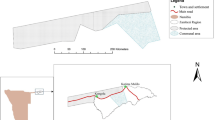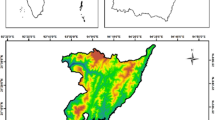Abstract
The rate and intensity of land use land cover (LULC) change has increased considerably during the past couple of decades. Mining brings significant alterations in LULC specifically due to its impact on forests. Parts of Central India are well endowed with both forests and minerals. Here, the conflict between human interests and nature has intensified over time. Monitoring and assessment of such conflicts are important for land management and policy making. Remote sensing and Geographical Information System have the potential to serve as accurate tools for environmental monitoring. Understanding the importance of landscape metrics in land use planning is challenging but important. These metrics calculated at landscape, class, and patch level provide an insight into changing spatiotemporal distribution of LULC and ecological connectedness. In the present study, geospatial tools in conjunction with landscape metrics have been used to assess the impact of coal mining on habitat diversity. LULC maps, change detection analysis, and landscape metrics have been computed for the four time periods (1972, 1992, 2001, and 2006). There has been a significant decline in forest cover especially of the Sal-mixed forests, both in area as well as quality, due to flouted mining regulations. Reclamation of mined lands has also been observed in some of the areas since 2001.
Similar content being viewed by others
References
Almeida-Filho, R., & Shimabukuro, Y. E. (2000). Detecting areas disturbed by gold mining activities through JERS-1 SAR images, Roraima State, Brazilian Amazon. International Journal of Remote Sensing, 21(17), 3357–3362.
Apan, A. A., Raine, S. R., & Paterson, M. R. (2002). Mapping and analysis of changes in the riparian landscape structure of the Lockyer Valley catchment, Queensland, Australia. Landscape and Urban Planning, 59, 43–57.
Aryee, N. A. B., Ntibery, B. K., & Atorkui, E. (2003). Trends in the small-scale mining of precious minerals in Ghana: a perspective on its environmental impact. Journal of Cleaner Protection, 11, 131–140.
Chevrel, S., Kuosmannen, V., Belocky, R., Marsh, S., Tapani, T., Mollat, H., et al. (2001). Hyperspectral airborne imagery for mapping mining related contaminated areas in various European environments—First results of MINEO project. In 5th international airborne remote sensing conference, San Francisco, California, 17th–20th September.
Fragstats Documentation (1995). [Online]. Available on: http://www.umass.edu/landeco/research/fragstats/documents/fragstats_documents.html (accessed on 25.10.08).
Ghose, M. K. (2003). Indian small-scale mining with special emphasis on environmental management. Journal of Cleaner Protection, 11, 159–165.
Golubiewski, N. E., & Hussein, G. H. (2007). Remote sensing’s functional role in studies of land-use/land-cover change. In J. Cutler (Ed.), Cleveland encyclopedia of earth. Washington, D.C.: Environmental Information Coalition, National Council for Science and the Environment, [Published in the Encyclopedia of Earth March 15, 2007; Retrieved December 14, 2008].
Huettl, R. F. (1998). Ecology of post strip-mining landscapes in Lusatia Germany. Environmental Science and Policy, 1, 129–135.
IIRS (2007). Biodiversity characterisation at landscape level in Central Indian and West Bengal using satellite remote sensing and geographical information system (p. 542). Indian Institute of Remote Sensing (National Remote Sensing Agency), Department of Space, Government of India, Dehradun 248 001.
Joshi, P. K., Kumar, M., Midha, N., Vija Yanand, & Pali Wal, A. (2006). Assessing areas deforested by coal ming activities through satellite remote sensinf images and GIS in parts of Korba, Chattisgarh. Journal of the Indian Society of Remote Sensing, 34(4), 415–421.
Joshi, P. K., Kumar, M., Paliwal, A., Midha, N., & Dash, P. (2008). Assessing impact of industrialization in terms of LULC in a dry tropical region (Chhattisgarh), India using remote sensing data and GIS over a period of 30 years. Environmental Monitoring and Assessment, 149(1–4), 371–376.
Kepner, W. G., Watts, C. J., Curtis, E. M., Maingl, J. K., Marsh, S. E., & Luna, G. (2000). A landscape approach for detecting and evaluating change in a semi arid environment. Environmental Monitoring and Assessment, 64, 179–195.
Lattofovic, R., Fytas, K., Chen, J., & Paraszczak, J. (2005). Assessing land cover change resulting from large surface mining development. International Journal of Applied Earth Observation and Geoinformation, 7, 29–48.
Ottl, H., Roth, A., Voigt, S., & Mehl, H. (2002). Spaceborne remote sensing for detection and impact assessment of coal fires in North China. Acta Astronautica, 5, 569–578.
Prakash, A., & Gupta, R. P. (1998). Land use mapping and change detection in a coal mining area: A case study in the Jharia coal field. International Journal of Remote Sensing, 19(3), 391–410.
Pranato, A. K., Gikes, B., & Mengler, F. C. (2004). The use of remotely sensed data to analyze spatial and temporal trends in patchiness within rehabilitated bauxite mines in the Darling Range, Super Soil 2004, available online at: http://www.regional.org.au/au/asssi/supersoil2004/s5/oral/1459_pranantoa.htm (accessed on: 12/10/08).
Puyravaud, J. (2003). Standardizing the calculation of the annual rate of deforestation. Forest Ecology and Management, 177, 593–596.
Sarma, K. (2005). Impact of coal mining on vegetation: case study of Jaintia hills, district of Meghalaya, India. PhD thesis, International Institute for Geoinformation Science and Earth Observation. Available online at: http://www.itc.nl/library/Papers_2005/msc/ereg/sarma.pdf (accessed on: 12/11/08).
Stuart, M., Cotton, H. C., Ager, G., Tragheim, D. G. (2000). Detecting mine pollution using hyperspectral data in temperate, vegetated European environments. In Proceedings of the fourteenth international conference on applied geologic remote sensing, 6–8 November 2000, Las Vegas, NV, Veridian ERIM International Conferences, Ann Arbor, MI.
Swer, S., & Singh, O. P. (2004). Status of water quality in coal mining areas of Meghalaya, India. In Proceedings of the national seminar on environmental engineering with special emphasis on mining environment, NSEEME-2004, 19–20 March.
Tiwary, R. K., & Dhar, B. B. (1994). Environmental Pollution from coal mining activities in Damodar River Basin, India. Mine Water and the Environment, 13, 1–10.
Townsend, P. A., Helmers, D. P., Klayton, C. K., Mc Niel, B. E., De Beurs, K. M., & Ehsleman, K. N. (2008). Changes in the extent of surface mining and reclamation in the Central Appalachians detected using a 1976–2006 Landsat time series. Remote Sensing of Environment, 111(1), 62–72.
Vagholikar, N., Moghe, K. A., & Dutta, R. (2003). Undermining India: Impacts of mining in ecologically sensitive areas. Pune: Kalpavriksha.
Voigt, S., Tetzlaffa, A., Zhanga, J., Kynzera, C., Zhukova, B., Gunter, S., et al. (2004). Integrating satellite remote sensing techniques for detection and analysis of uncontrolled coal seam fires in North China. International Journal of Coal Geology, 59, 121–136.
Yelpaala, K., & Ali, S. H. (2005). Multiple scales of diamond mining in Akwatia, Ghana: Addressing environmental and human development impact. Resources Policy, 30(3), 1–11.
Author information
Authors and Affiliations
Corresponding author
Rights and permissions
About this article
Cite this article
Malaviya, S., Munsi, M., Oinam, G. et al. Landscape approach for quantifying land use land cover change (1972–2006) and habitat diversity in a mining area in Central India (Bokaro, Jharkhand). Environ Monit Assess 170, 215–229 (2010). https://doi.org/10.1007/s10661-009-1227-8
Received:
Accepted:
Published:
Issue Date:
DOI: https://doi.org/10.1007/s10661-009-1227-8




